Table of Contents
Come join us now, and enjoy playing your beloved music and browse through great scores of every level and styles!
Can’t find the songbook you’re looking for? Please, email us at: sheetmusiclibrarypdf@gmail.com We’d like to help you!
Sorabji: In the Hothouse (from Two Piano Pieces) sheet music, Noten, partitura, spartiti 楽譜

Best Sheet Music download from our Library.

Please, subscribe to our Library.
If you are already a subscriber, please, check our NEW SCORES’ page every month for new sheet music. THANK YOU!
Browse in the Library:
Or browse in the categories menus & download the Library Catalog PDF:
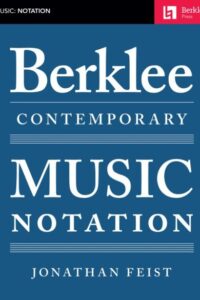
Who was Sorabji?
Kaikhosru Shapurji Sorabji: The Hermit of Modernist Maximalism
In the often-crowded pantheon of 20th-century composers, Kaikhosru Shapurji Sorabji (1892-1988) occupies a unique and enigmatic niche. A composer of staggering ambition, labyrinthine complexity, and self-imposed isolation, Sorabji crafted some of the most monumental, technically demanding, and stylistically idiosyncratic music ever conceived. His work, largely ignored during his lifetime and still challenging audiences today, represents a singular path through modernism – one defined by maximalism, intricate ornamentation, transcendental virtuosity, and a fierce, almost hermetic, independence.

Biography: A Self-Forged Identity
- Birth & Heritage: Born Leon Dudley Sorabji on August 14, 1892, in Chingford, Essex, England. His father was a Parsi engineer from India (thus the Persian-derived name Sorabji), and his mother was English-Spanish. This mixed heritage profoundly shaped his sense of identity, though he felt alienated from both cultures.
- The Name: Around 1914, he legally changed his name to Kaikhosru Shapurji Sorabji. “Kaikhosru” and “Shapurji” were Persian names chosen for their resonance and connection to ancient Persian history and Zoroastrianism, reflecting his deliberate construction of a unique persona.
- Musical Formation: Largely self-taught. He received some piano lessons in his youth but had no formal composition training. His musical education came through voracious listening, score study (especially Bach, Liszt, Busoni, Debussy, Ravel, Scriabin, Szymanowski, Medtner), and wide reading in literature, philosophy, and the occult.
- Early Career & Criticism: Worked as a music critic (under the pseudonym “S. Godfrey”) for outlets like The New Age and The New English Weekly from the 1910s to the 1930s. His critiques were famously acerbic, insightful, and often scathing, particularly targeting English musical provincialism and composers he deemed mediocre (which was most of them).
- The Recluse: Deeply disillusioned by the musical establishment and critical reception to his early performances (which were rare and often controversial), Sorabji gradually withdrew from public musical life starting in the late 1930s. After his mother’s death in 1940, he retreated almost completely to his secluded home “The Eye” in Corfe Castle, Dorset, where he lived with his companion, Reginald Norman Best, until his death. He forbade performances of his music for decades.
- The Ban Lifted: In 1976, pressured by a growing underground interest spearheaded by pianists like Yonty Solomon and Alistair Hinton (who later became his literary executor), Sorabji reluctantly lifted the ban on performances, provided he approved the performer.
- Death: Sorabji died on October 15, 1988, in Winfrith Newburgh, Dorset, leaving behind a colossal legacy of unpublished manuscripts.
Works: Monuments of Sound

Sorabji’s output is vast and overwhelmingly dominated by solo piano music, though he also composed orchestral works, chamber music, organ symphonies, and songs. His works are renowned for their extreme length, density, and technical difficulty, pushing the boundaries of playability.
- Key Masterpieces:
- Opus Clavicembalisticum (1930): His most famous (or infamous) work. A colossal 4+ hour piano epic in 12 movements (including fugues, passacaglias, toccatas, cadenzas), often considered one of the most challenging solo piano works ever written. A summit of contrapuntal complexity and virtuosic display.
- Symphonic Variations for Piano (1935-37): Another monumental work, exploring vast variation forms over an extended duration.
- Sequentia Cyclica super “Dies iræ” ex Missa pro Defunctis (1948-49): A massive cycle of 27 variations on the “Dies Irae” chant, demonstrating his intricate contrapuntal and transformative skills.
- 100 Transcendental Studies (1940-44): True to their name, these studies explore extreme technical and expressive demands far beyond those of Liszt or Chopin.
- Symphonies for Solo Piano: Several exist, including his Symphony No. 2 (“Jāmī”), blending orchestral textures and scope onto the piano.
- Gulistān – Nocturne for Piano (1940): A prime example of his lush, perfumed, and incredibly intricate “Persian”-inspired style.
- Concerti: He wrote several for solo piano and orchestra (e.g., Concerto per suonare da me solo e senza orchestra, per divertirsi), which are symphonic in scale and require superhuman virtuosity.
- Symphonies for Organ: Vast, complex works exploring the sonic possibilities of the instrument.
Analysis of Style: A Universe of Complexity
Sorabji’s style is instantly recognizable yet difficult to categorize. It synthesizes diverse elements into a unique and overwhelming whole:
- Maximalism: This is the defining characteristic. Sorabji embraced extremes:
- Length: Works lasting several hours are common.
- Density: Highly polyphonic textures, often with multiple independent melodic lines woven together in complex counterpoint (influenced by Bach, Busoni).
- Virtuosity: Demands transcendental technique – cascades of notes, complex polyrhythms, wide leaps, immense power, and extreme delicacy. He wrote as if the pianist had four hands.
- Ornamentation: Baroque-like ornamentation (trills, mordents, turns, grace notes) is ubiquitous, often layered and integral to the texture, creating shimmering, kaleidoscopic surfaces (influenced by Scriabin, Szymanowski, Middle Eastern/Persian music).
- Dynamic Range: From barely audible whispers to thunderous, percussive climaxes.
- Harmony: A complex fusion:
- Rooted in late-Romantic chromaticism (Scriabin, Szymanowski, early Schoenberg).
- Freely employed dissonance, clusters, and intricate chord structures.
- Often retained a sense of tonal centers or polarity, even amidst dense chromaticism (unlike strict atonality).
- Incorporated modal inflections, sometimes evoking Persian or Spanish flavors.
- Rhythm: Highly complex and fluid:
- Frequent use of polyrhythms (multiple simultaneous rhythms), cross-rhythms, and nested tuplets (triplets within quintuplets, etc.).
- Tempo often fluctuates wildly, requiring immense control.
- A sense of improvisatory freedom within highly structured forms.
- Form: Often large-scale, complex, and idiosyncratic:
- Favored variations (passacaglias, chaconnes), fugues, toccatas, and intricate multi-movement structures (like the Opus Clavicembalisticum).
- Forms were often expansive and cumulative, building through layered repetition and intensification rather than traditional development.
- Architecture was paramount, even in the densest textures.
- Influences (Assimilated, Not Imitated):
- Ferruccio Busoni: The most profound influence. Busoni’s ideas of “Young Classicism,” the transcendental potential of the piano, the fusion of Bachian counterpoint with modern harmony, and the concept of “Junge Klassizität” resonated deeply. Sorabji dedicated his Opus Clavicembalisticum to Busoni’s memory.
- Franz Liszt: Virtuosity, thematic transformation, large-scale forms, and the symphonic poem concept translated to piano.
- J.S. Bach: Contrapuntal mastery, structural rigor, and the use of forms like fugue and passacaglia.
- Alexander Scriabin: Mysticism, harmonic language, dense textures, and ecstatic climaxes.
- Karol Szymanowski: Sensuous harmony, intricate ornamentation (especially in the “Persian” inspired works like Métopes and Masques), and voluptuous textures.
- Debussy & Ravel: Color, texture, exoticism, and pianistic refinement.
- Mediterranean & Persian Cultures: While not authentically recreating these styles, he evoked their essence through ornamentation, melodic turns, and titles (Gulistān, Jāmī), reflecting his fascination with his Persian heritage and the wider Orient.
- Aesthetic: Sorabji’s music aimed for:
- Transcendence: Pushing beyond perceived limits of instrument, performer, and listener.
- Luxuriance & Opulence: A rich, sensual, almost decadent sound world.
- Intellectual Rigor: Underlying the sensual surface was meticulous structural planning.
- Individualism: A complete rejection of prevailing trends (serialism, neoclassicism, minimalism) in favor of his own uncompromising vision.
Legacy: From Obscurity to Cult Status
Sorabji’s legacy is complex and evolving:
- Decades of Neglect: His self-imposed exile and performance ban meant his music was virtually unknown outside a tiny circle for nearly 40 years. Manuscripts were inaccessible, unplayable, and unpublished.
- The Pioneers (1970s-): The lifting of the ban sparked interest. Pianists like Yonty Solomon, Michael Habermann, Geoffrey Douglas Madge (who made the first complete recording of Opus Clavicembalisticum in 1977), and later Marc-André Hamelin, Jonathan Powell, Fredrik Ullén, and Ronald Stevenson began the monumental task of learning, performing, and recording his works. This required immense dedication and technical prowess.
- Publication & Scholarship: The Sorabji Archive, established by Alistair Hinton (Sorabji’s literary executor), has been crucial in cataloging, editing, and facilitating the publication of scores (primarily by Dover Publications and The Sorabji Music Archive). Scholarly work is gradually increasing.
- Recordings Renaissance: The CD era and digital distribution (YouTube, streaming) have been transformative. Dedicated labels (Altarus, BIS, Toccata Classics, Piano Classics) have released numerous recordings, making this once-inaccessible music available globally. Complete cycles of the 100 Studies and other major works are underway.
- The Cult & The Challenge: Sorabji remains a “composer’s composer” and a cult figure. His music is not mainstream concert fare due to its extreme demands and duration. However, it commands deep respect and fascination among pianists, composers, and listeners drawn to its unique sound world and uncompromising vision. He is seen as the ultimate iconoclast, forging a path utterly independent of 20th-century musical fashions.
- Influence: His direct influence on other composers is hard to pinpoint due to his obscurity, but he stands as a powerful symbol of uncompromising artistic integrity and the exploration of extreme complexity and virtuosity. Composers interested in maximalism, intricate counterpoint, or pushing pianistic limits inevitably encounter his shadow.
- Copyright Controversy: The complex copyright status of his works (involving the Sorabji Archive and publishers) has sometimes been a point of friction within the community of performers and scholars seeking access.
Sorabji: The Solitary Giant
Kaikhosru Shapurji Sorabji was a true original. He inhabited a musical universe entirely of his own making, synthesizing diverse influences into a style characterized by unparalleled complexity, sensuous opulence, and transcendental ambition. His deliberate withdrawal from the world ensured decades of obscurity, but the dedication of pioneering performers and the power of recording technology have brought his extraordinary soundscapes to light. While his music remains challenging and demanding, it offers unparalleled rewards: a journey into a world of labyrinthine beauty, overwhelming power, and intellectual fascination. Sorabji stands as a testament to the power of an utterly individual artistic vision, uncompromising in its scope and ambition, a solitary giant whose monumental creations continue to challenge and inspire. He redefined the possible for the piano and left a legacy that continues to unfold as more performers dare to scale his musical Himalayas.
“In the Hothouse” is one of Sorabji’s most evocative and frequently performed works, serving as a perfect entry point into his dense, sensuous sound world. Here’s a detailed look at this fascinating piece:
Context: Two Piano Pieces (1918)
- Composed: 1918 (early in Sorabji’s career, age 26).
- Publication: First published in 1920, making it one of the earliest Sorabji works available in print.
- The Pair: “In the Hothouse” is paired with “Toccata” – a contrasting, hyper-virtuosic, and structurally complex piece showing his Busoni/Liszt influences. “In the Hothouse” offers the sensual, atmospheric counterpoint.
- Significance: Represents Sorabji’s early mastery of texture, harmony, and evocative atmosphere. It predates his gargantuan works but already displays his unique voice.
“In the Hothouse”: A Sensory Immersion
- Title & Imagery: The title instantly conjures an environment: humid, lush, teeming with exotic, overripe plant life, heavy perfumes, and stifling, enclosed heat. Sorabji translates this sensory overload into sound.
- Form & Structure: Relatively free and rhapsodic. It unfolds as a continuous, organic stream of consciousness rather than adhering to strict classical forms. Think of it as an elaborate, decadent arabesque.
- Style & Character:
- Extreme Sensuality: This is the defining feature. The music drips with lush, complex harmonies and suffocatingly rich textures.
- Harmony: Deeply chromatic, rooted in late Scriabin and early Szymanowski. Expect dense, constantly shifting chords: augmented harmonies, whole-tone inflections, unresolved dissonances creating tension, and sudden moments of surprising consonance like shafts of light piercing foliage. It avoids traditional tonality but gravitates around implied centers.
- Texture: Thick, layered, and constantly in motion. Tremolos, trills, rapid filigree (ornamental passages), and cascading arpeggios create a shimmering, humid haze. Melodies are often embedded within this dense undergrowth rather than standing clearly apart. The writing often requires the pianist to sustain multiple layers simultaneously.
- Rhythm: Fluid and flexible, often obscured by the sheer density of notes and ornamentation. Rubato (expressive tempo fluctuations) is essential. While less overtly complex polyrhythmically than his later works, the rhythmic flow feels organic and improvisatory.
- Dynamics & Articulation: Wide dynamic range, often shifting suddenly between extremes (e.g., thunderous climaxes collapsing into fragile whispers). Articulation varies from sharp staccatos to legatissimo passages that blur together. Pedaling is crucial for sustaining the harmonic haze and creating resonance.
- Ornamentation: Quintessential early Sorabji. Trills, mordents, turns, and grace notes are not mere decoration; they are the texture, creating constant flickering movement and contributing to the claustrophobic, teeming atmosphere. This foreshadows the intricate ornamentation dominating his mature style.
- Emotional Landscape: Evokes opulence, decadence, languor, mystery, stifling heat, hidden dangers, and overwhelming sensory stimulation. There’s a sense of beauty bordering on the grotesque due to its sheer intensity.
Influences Audible in “In the Hothouse”
- Scriabin (Primary): The harmonic language (mystic chords, unresolved dissonance, ecstatic climaxes), the sensual atmosphere, and the use of trills/tremolos are deeply indebted to Scriabin’s late sonatas and poems (e.g., Vers la flamme). Sorabji pushes Scriabin’s decadence further.
- Szymanowski: The opulent textures, perfumed harmonies, and “orientalist” exoticism (though abstracted here) strongly recall Szymanowski’s “Métopes” or “Masques,” which Sorabji admired deeply.
- Debussy: The focus on atmosphere, texture, and harmonic color (whole-tone scales, parallel chords) shows Debussy’s influence, though rendered with far greater density and intensity.
- Ravel: The virtuosic filigree and lush harmonies (think “Gaspard de la Nuit,” especially “Ondine” or “Le gibet”) are a touchstone, again amplified.
- Liszt: The rhapsodic freedom and dramatic gestures hint at Liszt, though filtered through a post-Scriabinesque lens.
Performance Challenges
- Texture & Balance: Maintaining clarity amidst the dense, rapidly shifting textures is paramount. The pianist must carefully voice chords and layers to prevent muddiness while sustaining the essential harmonic haze.
- Ornamentation as Texture: Executing the constant ornamentation smoothly and evenly, integrating it into the melodic and harmonic flow rather than treating it as mere decoration.
- Dynamic Control: Navigating the extreme dynamic contrasts and sudden shifts without sounding jarring. Creating a true pianissimo shimmer within complexity is incredibly difficult.
- Rubato & Phrasing: Applying expressive tempo fluctuations naturally while maintaining the overall structural coherence and forward momentum of the rhapsodic form.
- Pedaling: Using the pedal to create resonance and blend without causing harmonic blurring or loss of rhythmic definition. Requires exceptional sensitivity.
- Stamina & Focus: While shorter than his later works (typically 12-15 minutes), the piece demands intense concentration and physical control to sustain the atmosphere and navigate the technical intricacies.
Legacy & Significance of “In the Hothouse”
- Accessibility: It remains one of Sorabji’s most “accessible” works due to its evocative title, relatively shorter duration, and concentrated expression. It’s a frequent choice for pianists introducing audiences to Sorabji.
- Blueprint: It serves as a crucial blueprint for Sorabji’s mature style, showcasing his core preoccupations: sensuality, harmonic density, intricate ornamentation as texture, and atmospheric evocation, all present in embryonic form.
- Performance History: Despite Sorabji’s later ban, “In the Hothouse” (along with the Toccata) was one of the few pieces occasionally performed during his lifetime (e.g., by Sorabji himself and pianist Reginald Paul) and became a key work for the pioneering generation post-1976 (Yonty Solomon, Michael Habermann, Marc-André Hamelin, Jonathan Powell, Fredrik Ullén).
- Gateway Piece: It functions as a vital “gateway drug” into Sorabji’s world. Its success in conveying its intense atmosphere often encourages listeners to explore his more monumental, complex works.
- Standalone Masterpiece: Regardless of its role as an introduction, it stands as a perfectly formed and powerful piece of early modernist piano writing, a miniature tone poem of extraordinary evocative power.
“In the Hothouse” is a sun-drenched, overripe, and intoxicating immersion into Sorabji’s unique aesthetic. It captures the essence of his sensual maximalism in a concentrated dose, showcasing his debt to Scriabin and Szymanowski while asserting his own distinct voice. Its evocative power, technical brilliance, and relative brevity ensure its enduring place as one of his most beloved and frequently performed works, offering a compelling glimpse into the hothouse of Sorabji’s extraordinary musical imagination.
| Artist or Composer / Score name | Cover | List of Contents |
|---|---|---|
| Matt Herskowitz Bach A La Jazz (Piano Solo) | Matt Herskowitz Bach A La Jazz (Piano Solo) | |
| Matthay, Tobias Elves (Die Elfen) | ||
| Matthay, Tobias – The Visible And Invisible In Piano Technique (1947) | The Visible And Invisible In Pianoforte Technique (By Tobias Matthay) | |
| Matthay, Tobias The First Principles Of Pianoforte Playing (1905) | Book Theory | |
| Mattia Cupelli Touch (Easy Piano Sheet Music) |
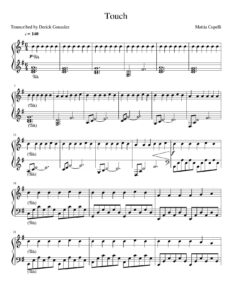 |
|
| Matz Carol – The Sorcerer |
 |
|
| Maurice Jarre Francis Webster Doctor Zhivago Somewhere My Love Lara’s Theme |
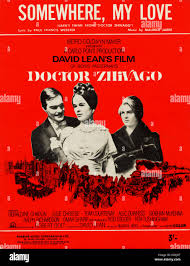 |
Jarre – Somewhere My Love (from Doctor Zhivago) |
| Maurice Jarre Somewhere My Love Laras Theme From Doctor Zhivago Piano Vocal Guitar |
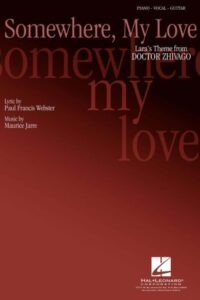 |
|
| Maurice Lieberman Keyboard Harmony and Improvisation Vol 1 |
 |
|
| Max Payne 3 – Main Menu Themes (4) Piano Solo sheet music |
 |
|
| Max Payne 3 Late Goodbye Piano Sheet Music |
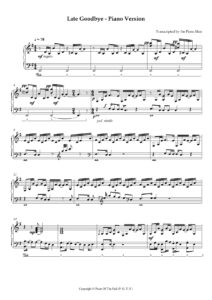 |
|
| Max Payne Game Original Theme (Piano) |
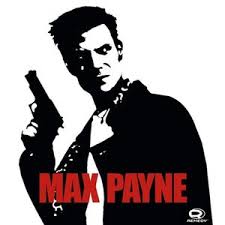 |
|
| Max Payne Main Theme Piano Solo Kärtsy Hatakka & Kimmo Kajasto (Piano Solo) |
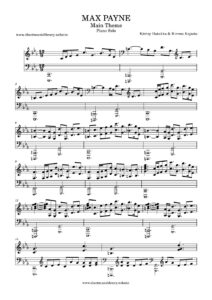 |
|
| Max Payne Main Theme Piano Solo Kärtsy Hatakka & Kimmo Kajasto.mscz | ||
| Max Reger Modulation (book) |
 |
|
| Max Richter On The Nature Of Daylight (Piano Solo arr.) |
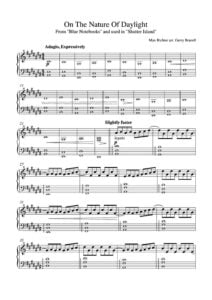 |
|
| Max Richter The Four Seasons Recomposed (Complete) Full Score for Orchestra |
 |
Max Richter The Four Seasons Recomposed (Complete) |
| Max Richter – A Catalogue of Afternoons |
 |
|
| Max Richter – Departure Lullaby (from The Leftlovers) | Max Richter – DepArture Lullaby | |
| Max Richter – Horizon Variations (Musescore File).mscz | ||
| Max Richter – Horizons Variations |
 |
|
| Max Richter – Lamentation for a lost Life from TABOO TV Series (Peaceful Piano Solos) | Max Richter – Lamentation for a lost Life from TABOO TV Series (Peaceful Piano Solos) | |
| Max Richter – Prelude 6 |
 |
|
| Max Richter – Vladimir’s Blues |
 |
|
| Max Richter – Vladimir’s Blues guitar arr. |
 |
|
| Max Richter – Vladimir’s Blues Guitar Arr. (Musescore File).mscz | ||
| Max Richter – Written on the sky | Max Richter written on the sky | |
| Max Richter A Catalogue Of Afternoons (Musescore File).mscz | ||
| Max Richter A Lamenting Song |
 |
|
| Max Richter Book Piano Works |
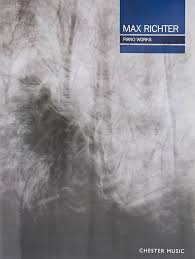 |
Max Richter Book Piano Works |
| Max Richter Dream 1 By Max Richter From Sleep Befre The Wind Blows It All Away | Max Richter Dream 1 By Max Richter From Sleep Befre The Wind Blows It All Away | |
| Max Richter Embers |
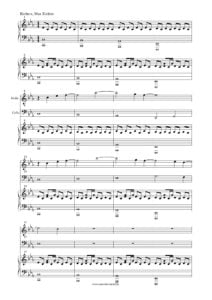 |
|
| Max Richter H In New England |
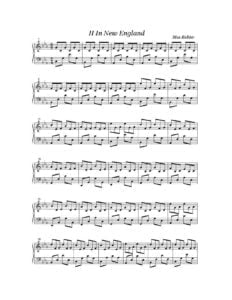 |
|
| Max Richter Infra 3 |
 |
|
| Max Richter November For Violin And Piano |
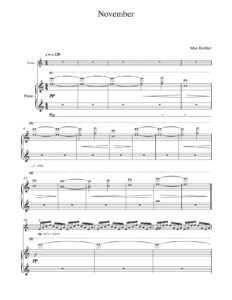 |
|
| Max Richter Only Questions_ |
 |
|
| Max Richter Summer Recomposed Vivaldi’s Four Seasons Piano Solo |
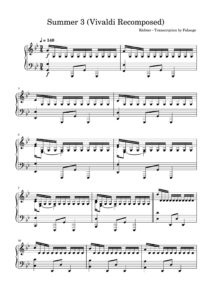 |
|
| Max Richter Taboo Piano Solo Sheet Music |
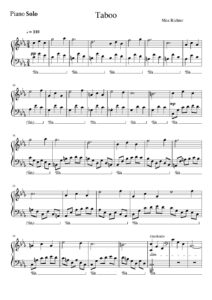 |
|
| Max Richter The Departed (Leftovers ) | Max Richter The Leftovers | |
| Max Richter The End Of All Our Exploring From The Leftlovers |
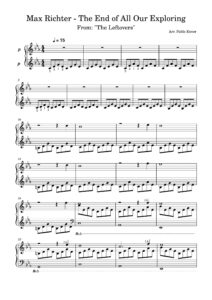 |
|
| Max Richter The Twins |
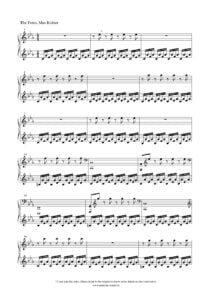 |
|
| Max Richter Winter Recomposed Vivaldi’s Four Seasons Piano Solo |
 |
|
| Max Steiner – My own true love (Gone With The Wind)- Tara’s Theme (Piano, voice & guitar) |
 |
|
| Max Steiner A Summer Place |
 |
|
| Maxence Cyrin Mer De Velours From Aurora | Maxence Cyrin Mer De Velours From Aurora | |
| Maxime Le Forestier San Fransico (Piano Solo And Piano Vocal) |
 |
|
| Maxime Le Forestier – La Petite Fugue pour 2 Voix |
 |
|
| Maxime Le Forestier 40 Chansons |
 |
|
| Maxime Le Forestier Collection Quelques Chansons Mises A Part | Maxime Le Forestier Collection Quelques Chansons Mises A Part | |
| Maxime Le Forestier Passer Ma Route Songbook |
 |
|
| Maxime Le Forestier Recueil Special Piano 3 Partitions (Transcription Michel Leclerc) |
 |
|
| Maximo Diego Pujol – Suites Del Plata Guitarra guitar |
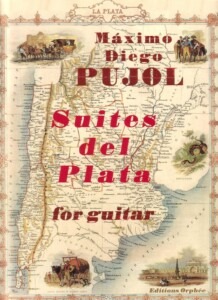 |
|
| Maximo Diego Pujol Los Caminos De La Luz Guitar Solo |
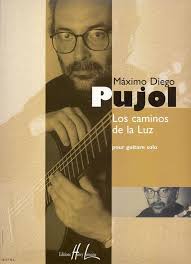 |
|
| Maxwell Eckstein Early Technical Studies From Schmitt And Hanon |
 |
|
| Maxwell Eckstein Rhapsodie |
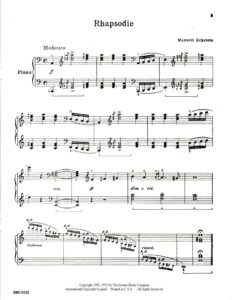 |
|
| Maxwell Eckstein Spooks |
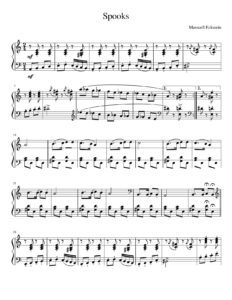 |
|
| Maybelle Carter Carter Style Guitar Solos |
 |
Maybelle Carter Carter Style Guitar Solos |
| Mayumi Kato – Morning Coffee | Mayumi Kato – Morning Coffee | |
| Mayumi Kato Cherry Blossoms Shower In Spring Wind |
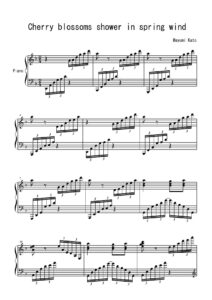 |
|
| Mayumi Kato Deep Secret Op .2 no. 2 |
 |
|
| Mayumi Kato Destiny |
 |
|
| Mayumi Kato Etude | ||
| Mayumi Kato Forbidden fruit | ||
| Mayumi Kato Guilty |
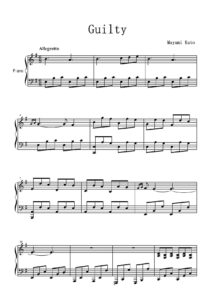 |
|
| Mayumi Kato KYOTO | Mayumi-Kato-KYOTO 1st page | |
| Mayumi Kato Last Scene |
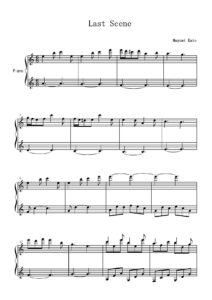 |
|
| Mayumi Kato LIAR |
 |
|
| Mayumi Kato Old Days |
 |
|
| Mayumi Kato Op.11 Geisha |
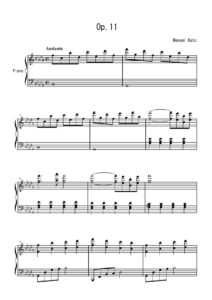 |
|
| Mayumi Kato Orange Moon |
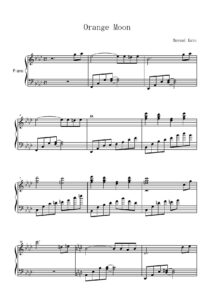 |
|
| Mayumi Kato Rainy Day | Mayumi-Kato-Rainy-Day 1st page | |
| Mayumi Kato Red |
 |
|
| Mayumi Kato Romance Op7-2 | Mayumi-Kato-Op7-2-never 1st page | |
| Mayumi Kato Say Goodbye |
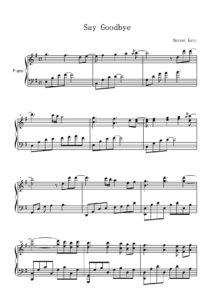 |
|
| Mayumi Kato Secret Garden |
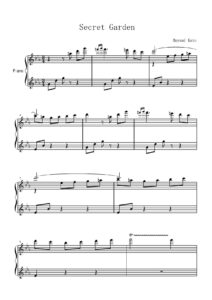 |
|
| Mayumi Kato Silver Moon |
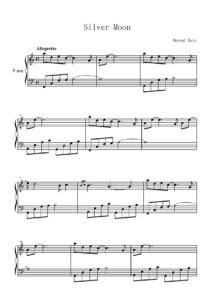 |
|
| Mayumi Kato Snow | Mayumi Kato Snow | |
| Mayumi Kato Snow Land | Mayumi Kato Snow Land | |
| Mayumi Kato The Bamboo Princess | ||
| Mayumi Kato The Prayer |
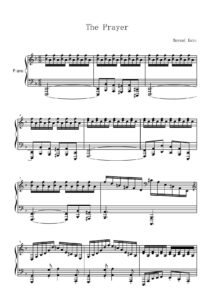 |
|
| Mazurka Cocktail | ||
| Mazurkas Cocktail | ||
| McCoy Tyner – There Is No Greater Love Full Score |
 |
|
| McCoy Tyner Blues on the corner | McCoy Tyner Blues on the corner | |
| McCoy Tyner Jazz Giants Artist Transcriptions |
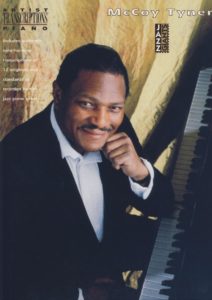 |
McCoy Tiner transcriptions |
| McCoy Tyner Jazz Improvisation |
 |
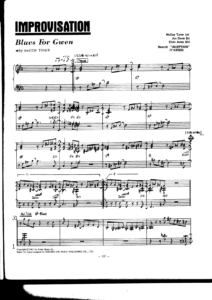 |
| McCoy Tyner Just Knock On My Door | McCoy Tyner Just Knock On My Door | |
| McCoy Tyner Plays Standards Transcriptions | McCoy Tyner play standards | |
| McCoy Tyner Pursuance | McCoy Tyner Pursuance | |
| McCoy Tyner Transcriptions Inception to now |
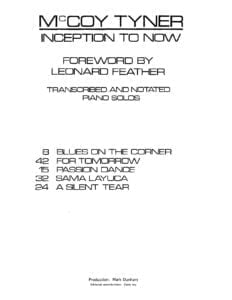 |
|
| Mcfly – All About You | ||
| Me cuesta tanto olvidarte (Mecano) | ||
| Meant to Be Sheet Music – Florida Georgia Line sheet music BEBE REXHA |
 |
|
| Meat Loaf – Anything For Love | ||
| Mecano Hijo De La Luna Partitura Completa piano solo |
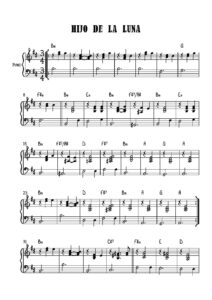 |
|
| Meditative Piano, Relax With – 40 Beautiful Pieces selected by Samantha Ward |
 |
Meditative Piano, Relax With 40 Beautiful Pieces |
| Medtner – 2 Cadenzas to Beethoven’s 4th Piano Concerto op. 58 – Score |
 |
|
| Medtner – Zwei Märchen (2 Tales) Op. 20 |
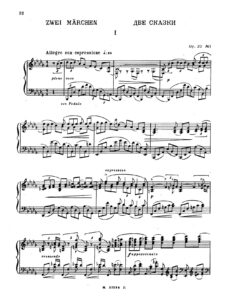 |
|
| Meet Joe Black – Forbidden Love – Thomas Newman |
 |
|
| Meet John Doe (The Musical) Piano Vocal By Music By Andrew Gerle Lyrics By Eddie Sugarman | Meet John Doe (The Musical) Piano Vocal By Music By Andrew Gerle Lyrics By Eddie Sugarman | |
| Meg – Crimes of the heart OST (Georges Delerue) | ||
| MEGADETH – RISK (Guitar songbook) |
 |
MEGADETH – RISK (Guitar songbook) |
| Megadeth Greatest Hits Back To The Start |
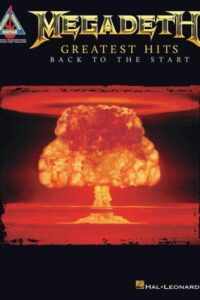 |
Megadeth Greatest Hits Back To The Start |
| Meglio stasera (It had better be tonight) The Pink Panther OST | ||
| Mel Bay – Classic Blues Licks For Electric Guitar (Play Along With Audio MP3 with Tablature) By Fred Sokolow |
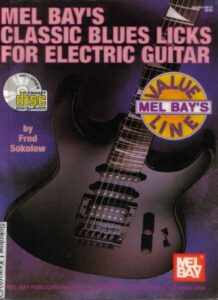 |
Classic Blues Licks |
| Mel Bay – Music Theory For The Rock Guitarist – Guitar Play Along With Mp3 Audio by Ben Bolt with Tablature |
 |
Guitar Lessons – Music Theory For The Rock Guitarist |
| Mel Bay – Rock Rhythms For Guitar (Play Along With Audio Mp3) by Mike Christiansen |
 |
Mel_Bay’s_Rock_Rhythms_For_Guitars |
| Mel Bay Art Of Rasgueado (Ioannis Anastassakis) Guitar Tablature |
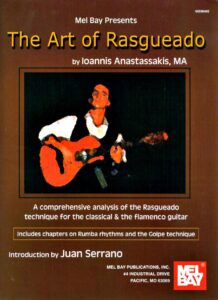 |
|
| Mel Bay Complete Giuliani Studies |
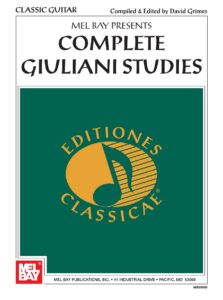 |
|
| Mel Bay Modern Guitar Method Complete Edition Vol. 1 to 7 with audio and video download |
 |
|
| Mel Bay’s 101 Jazz Guitar Licks with Tablature |
 |
|
| Mel Bonis Album Pour Les Tout Petits 20 Pieces Pour Piano |
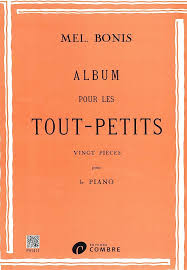 |
|
| Mel Bonis Cinq Pieces Pour Piano |
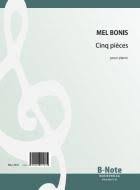 |
|
| Mel Bonis Scènes Enfantines pour piano |
 |
|
| Mel Brooks – Young Frankenstein The Musical by Mel Brooks & thomas Meehan |
 |
|
| Mel Brooks, The Songbook 23 Songs From Movies And Shows With A Preface By Mel Brooks 25 songs from movies and shows |
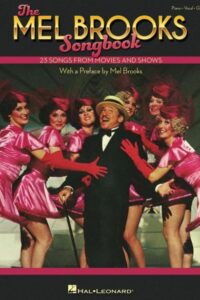 |
Mel Brooks, The Songbook 23 Songs From Movies And Shows With A Preface By Mel Brooks 25 songs from movies and shows |
| Melanie Laurent – Fin |
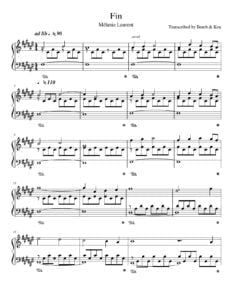 |
|
| Melanie Laurent Debut |
 |
|
| Melissa Etheridge Greatest Hits The Road Less Traveled (Songbook) Piano Vocal Guitar |
 |
Melissa Etheridge Greatest Hits The Road Less Traveled (Songbook) Piano Vocal Guitar |
| Melodic Studies For The Jazz Pianist by Larry Agrovino |
 |
|
| Melody Bober Pentascale Pro Book 1 |
 |
|
| Melody Bober Standout Solos For Recitals 10 Dramatic Pieces For Intermediate Level Piano |
 |
Melody Bober Standout Solos For Recitals 10 Dramatic Pieces For Intermediate Level Piano |
| Melody Bober Winter Wind Late Intermediate Piano |
 |
|
| Melody of the Night 5 Shi Jin | Melody-of-the-Night-5-Shi-Jin 1st page | |
| Melting Walts (Penny Dreadful OST) Abel Korzeniowski | ||
| Memories (Within Temptation) | ||
| Memories Of Green (Musescore File).mscz | ||
| Memory (Epica) | ||
| Memory (from Cats) Andrew Lloyd Webber |
 |
|
| Memory of Love (Yuhki Kuramoto & Sumi Jo) | ||
| Memphis A New Musical (Songbook) Piano vocal Selections (Melody In The Piano Part) David Bryan Joe DiPietro |
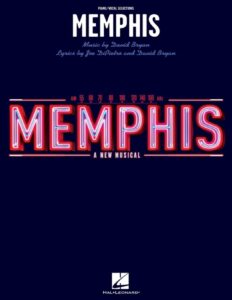 |
Memphis A New Musical (Songbook) Piano vocal Selections (Melody In The Piano Part) |
| Menahem Pressler Artistry In Piano Teaching (Book) |
 |
|
| Mendelssohn Auf Flugeln Des Gesanges (On Wings Of Song) |
 |
|
| Mendelssohn – Auf Flügeln des Gesanges |
 |
|
| Mendelssohn – Auf Flugeln Des Gesanges (On Wings Of Song) (Musescore File).mscz | ||
| Mendelssohn – Romance Au Bords Du Gange Transcription H. Maylath | ||
| Mendelssohn Auf Flugeln Des Gesanges (On wings of songs Op. 34.2) piano arr. Liszt |
 |
|
| Mendelssohn Klavierwerke 4 Lieder ohne Worte Op 30 | Mendelssohn Klavierwerke 4 Lieder ohne Worte Op 30 | |
| Mendelssohn op 19 no. 4 | ||
| Mendelssohn Op 30 6 Venetianishes Gondellied (Venetian Gondola Song) | Mendelssohn op 30 6 Venetianisches Gondellied | |
| Mendelssohn op 53 no. 4 | ||
| Mendelssohn Op 67 no. 1 Lieder ohne Worte | Mendelssohn Op 67 Lieder ohne Worte no. 31 | |
| Mendelssohn Op 85 no. 4 | ||
| Mendelssohn op. 53 no. 1 | ||
| Mendelssohn Symphony No. 3 in A minor Op. 56 Scottish 1st Movt. Piano solo arr. |
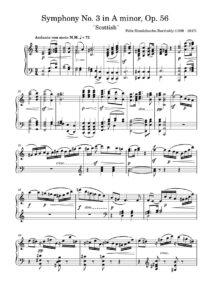 |
|
| Mendelssohn Symphony No. 3 In A Minor Op. 56 Scottish I Andante Con Moto Piano Solo Arr..Mscx.mxl | ||
| Mendelssohn Symphony No.3 op.56 Piano arr. 2 hands |
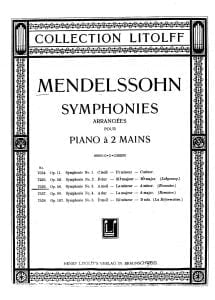 |
|
| Mendelssohn-Thalberg Auf Flugeln des Gesanges | Mendelssohn-Thalberg Auf Flugeln des Gesanges | |
| Meravigliosa creatura (Gianna Nannini) | ||
| Mercy Me – I Can Only Imagine |
